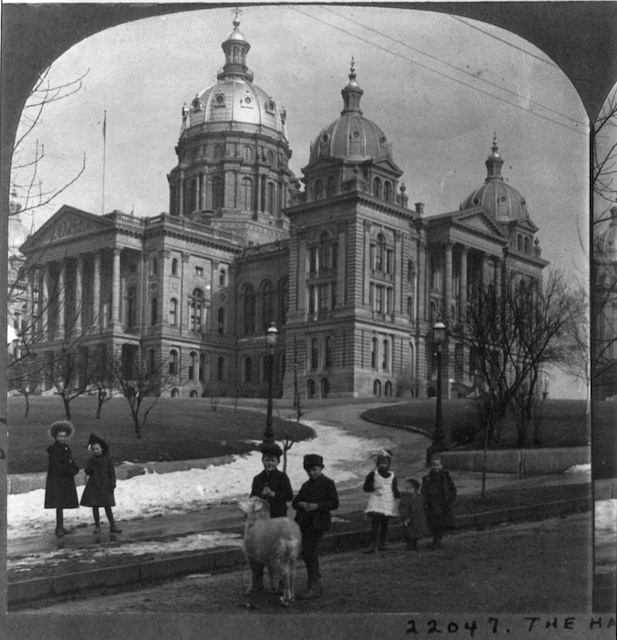
A goat and children at the Iowa State Capitol in Des Moines, 1906. Photo courtesy of the Library of Congress LC-DIG-stereo-1s12761
May/June 2022 (Volume 14, Issue 3)
By Cheryl Mullenbach
“To a person who has never seen the results of the presence of Angoras on brush lands, a ride through my lands is a revelation. Where, three years ago, the ground was densely covered with undergrowth of hazel, crab-tree, oak, buck-berry and other brush, it is now growing the finest blue grass. I have over 600 acres which have been reclaimed and the value of the land has been enhanced at least $10 an acre,” an Iowa goat farmer claimed in Farmers Voice in October 1899. About the same time another Iowan told the Prairie Farmer, “There is already an established boom in the Angora goat business in the United States.” With Angora hair (Mohair) selling for 40 cents per pound, he was raising the animals for their hair as well as for their delectable meat.
In the early 1900s Iowa farmers heeded the advice of agriculture experts who reported that Angora goats added $1 million to the value of Iowa land between 1899 and 1909. The goats cleared brush and weeds, preparing the land for cultivation. And, according to the experts, goats were relatively cheap to keep. They simply required a dry spot to sleep and occasionally some feed when it was too wet for them to go out to eat brush. The Anadarko, Oklahoma, Daily Democrat newspaper reported that one goat gave up anywhere from one and a half to 21 pounds of Mohair each year — the average between three and five pounds — with the price of Mohair bringing 16 cents to $6.50 per pound in 1909. “The goat is the only animal that will take the job of clearing our land and pile a great portion of the brush and weeds in his shed as manure and ask nothing for doing it,” according to the paper.
An Angora at the St. Louis World’s Fair in 1904 had been clipped of 19 pounds of hair which sold for $4.50 per pound. And at Charles City a couple of Iowa stockmen who leased a large tract of land at nearby Orchard had cleared the timber and turned a flock of 150 goats loose only to find their land nearly bare within a short time. A farmer in Ida Grove imported a carload of Angoras; and in record-breaking time, his land was cleared of brush and shrubbery.
By the time of the 13th U.S. Census in 1910 it was reported 2,400 Iowa farmers raised 20,664 goats and kids on their farms. While only 266 of those farmers produced Mohair, they reported 8,703 fleeces, weighing 29,206 pounds and valued at $7,261.
TO READ THE ENTIRE STORY AND OTHER FASCINATING STORIES ABOUT IOWA HISTORY, subscribe to Iowa History Journal.
